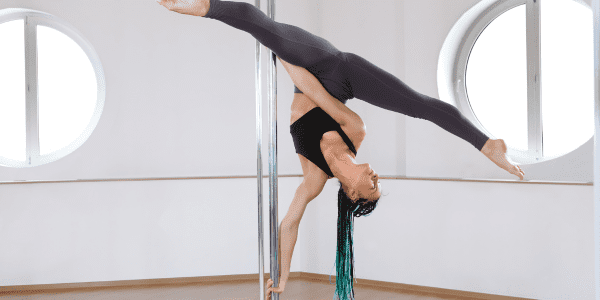Let Go of Your Inhibitions and Feel Sexy with Pole Fitness
Pole fitness has emerged in recent years as a popular way to get fit while building confidence and self-expression. For many women, it is a fun way to bring out their sexy side in a non-judgmental environment.
Those who regularly go to pole fitness classes will tell you just how great of an upper and lower body workout it is. Without a doubt, this type of workout is not for the faint of heart. But not to worry, even if you’re just starting out, you will catch on quickly and build up the strength to move into more advanced moves on the pole.
This guide on pole fitness will explore the origins, benefits, and tips for getting started with this unique and awesome workout.
Disclaimer: It is recommended that you speak with your doctor before starting any fitness program to ensure you are healthy enough to do so. There are inherent risks involved with this type of workout as well that you need to be aware of and understand.
Table of contents
- What is Pole Fitness?
- The History and Origins
- Is Pole Fitness a Good Workout?
- Do You Lose Weight with Pole Fitness?
- What’s the Difference Between Pole Fitness and Pole Dancing?
- Pole Fitness Techniques and Skills
- The Multitude of Benefits in Pole Classes
- How Many Times a Week Should You Do Pole Fitness?
- What Should You Wear to a Pole Fitness Class?
- Finding a Pole Fitness Studio and Instructor
- Can You Do Pole Fitness at Home?
- Safety and Precautions
- Start Exploring Your Pole Fitness Potential!
- FAQ
What is Pole Fitness?
Pole fitness utilizes vertical poles for dance, fitness, and acrobatics. Students perform climbs, spins, and inverted poses that require core strength, flexibility, grip, and coordination. Classes provide full-body training while boosting self-confidence in a judgment-free environment.
Compared to Mallakhamb or Chinese pole, modern pole sessions focuses more on health and fitness rather than performance. It offers an inclusive, empowering form of exercise for people of all backgrounds.
The History and Origins
Pole fitness has origins tracing back centuries to the ancient Indian sport Mallakhamb, which utilized wooden poles for gymnastic training and performance as early as the 12th century.
In the late 19th and early 20th centuries, pole dance and acrobatics became popular acts in traveling circuses and vaudeville shows, often referred to as “pole dancing.”
By the 1950s and 60s, pole’s entertainment appeal transitioned into erotic dance in strip clubs, shedding its fitness roots.

In the 1990s, promoters of pole as a competitive sport helped pole reemerge into the fitness scene by establishing international competitions, judging criteria, and branding it as “pole fitness.”
The early 2000s saw mainstream celebrities like Sheila Kelley popularize pole fitness, differentiating it from erotic dance by highlighting its athleticism. Pole studios began opening globally, training certified instructors, and forming national organizations.
Today, pole fitness continues to increase in popularity as a recognized way to build strength, flexibility, confidence, and empowerment for students of all backgrounds in a supportive environment.
Is Pole Fitness a Good Workout?
Yes, pole fitness is an excellent workout that offers many benefits:
- It’s a full-body workout. Pole fitness engages all the major muscle groups — arms, shoulders, back, core, glutes, and legs. It builds functional strength by using your own body weight as resistance.
- It improves flexibility. The stretches and poses in pole require and improve range of motion in hips, hamstrings, shoulders, and back over time.
- It enhances coordination and body awareness. The spins, transitions, and dance aspects demand coordination. You develop a greater mind-body connection.
- It provides cardio/aerobic exercise. A pole class keeps your heart rate up, especially during faster-paced dance combinations. It can burn 200-400 calories per hour.
- It tones and sculpts. The focus on the upper body and core builds lean muscle mass in your arms, back, shoulders, and abs.
- It’s low impact. Unlike high-impact workouts like running, pole puts less stress on your joints. It minimizes injury risk.
- It boosts confidence. Learning new skills and expressing yourself through dance is incredibly empowering. It pushes you out of your comfort zone.
Do You Lose Weight with Pole Fitness?
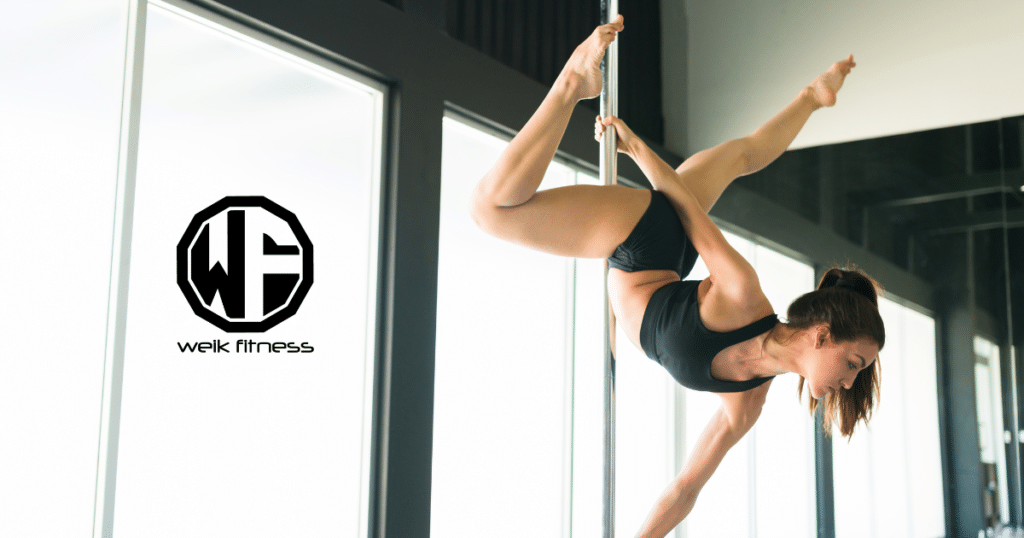
Yes, pole fitness can be an effective way to lose weight for several reasons:
- It’s a high-calorie burn. A one-hour pole dancing workout can burn anywhere from 200-400+ calories depending on your weight and intensity level. The more complex the moves, the more calories torched.
- It builds muscle. Pole fitness is a resistance workout that engages all major muscle groups. Building lean muscle mass boosts your metabolism, allowing you to burn more calories even at rest.
- It improves cardio endurance. Sustained pole dancing routines elevate your heart rate for an aerobic benefit. Better cardio endurance allows you to workout harder and longer.
- It enhances overall fitness. As your strength, flexibility, and coordination improve from pole classes, you’ll be able to perform more complex tricks that require exertion. Greater fitness allows more calorie burn.
- It provides motivation. The fun, empowering nature of pole fitness makes it easier to stick to than boring cardio machines. More consistency means greater fat loss over time.
While pole fitness alone may not lead to dramatic weight loss, combining it with a healthy diet and other exercise can certainly help you shed unwanted pounds in a fun way! Just be sure to start slow and focus on proper technique for best results.
What’s the Difference Between Pole Fitness and Pole Dancing?
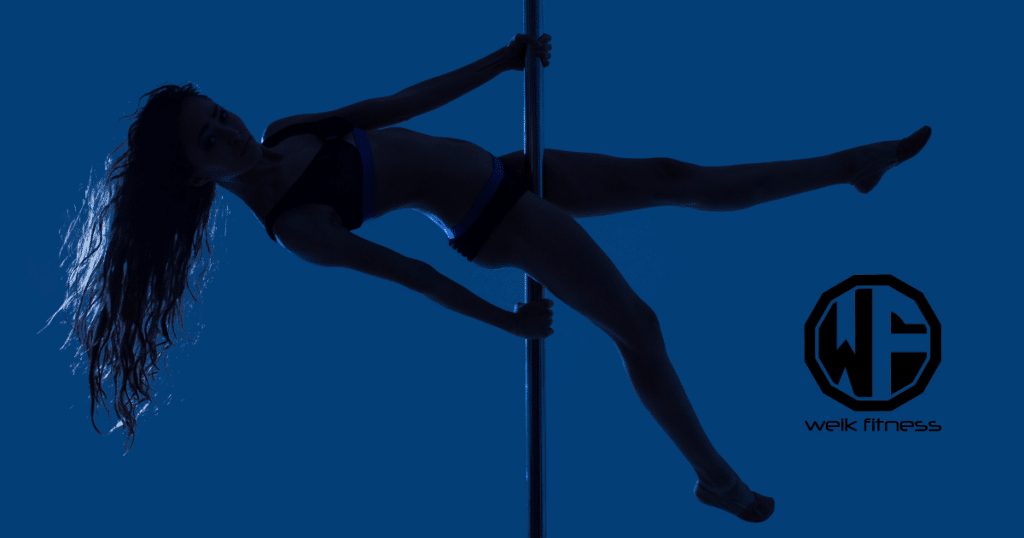
No disrespect to those of you who love pole fitness, but far too many times when the name is thrown around, in the heads of many, they are thinking of pole dancing. So, to clear the air and keep this rated PG, I felt it was necessary to explain the differences.
The main differences between pole fitness and pole dancing are:
- Goal: Pole fitness focuses on health and exercise, while pole dancing is more about sensuality and entertainment.
- Context: Pole fitness utilizes poles in a studio/class environment as gym equipment. Pole dancing occurs in nightclubs or on stage.
- Technique: Pole fitness emphasizes proper form and progressive skill building for safety. Pole dancing prioritizes performance, expression, and flair.
- Attire: Fitness poles require grippy shorts and bare skin. Pole dancers may wear sexy costumes and high heels.
- Tricks: Fitness tricks tend to be basic spins and transitions. Dance includes more dramatic poses and floor work.
- Music: Upbeat pop/dance music provides motivation during pole fitness classes. Pole dancing uses slower, more sensual music.
- Audience: Pole fitness students perform for their own satisfaction. Pole dancing entertains an audience.
Related Article: Fitness or Porn? What’s the Fitness Industry Coming To?
However, there is some crossover. Advanced polers may incorporate sensual dance, while competitive pole dancers perform incredible fitness-focused routines. But the general distinction lies in the purpose behind each one.
Pole Fitness Techniques and Skills
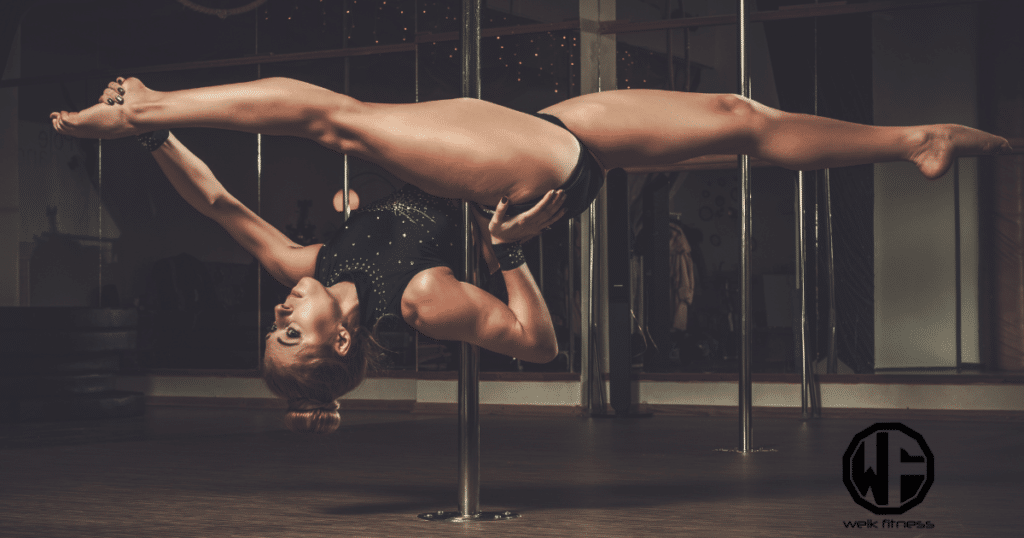
Beginners start by learning basic spins, climbs, and transitions between poses. Common beginner moves include fireman, pole sits, knee holds, and knee hooks. Core and upper body strength are emphasized.
Intermediate students advance to trickier moves like shoulder mounts, inverted poses, and butterfly spins. Combining skills into fluid dance sequences requires focus and control. Proper form prevents injury as tricks get harder.
Pole fitness allows creative expression like gymnastics while building functional strength using one’s own body weight. Students often see rapid improvements in grip strength, arm definition, abdominal tone, and overall fitness.
The Multitude of Benefits in Pole Classes
Regular pole classes offer many advantages:
- Full-body strength training with zero equipment required
- Increased flexibility and range of motion
- Better posture, coordination, and body awareness
- Fat burning and lean muscle development
- Confidence building in a body-positive environment
- Stress relief and a mood boost from exercise endorphins
The playful, uplifting nature of pole fitness makes it more enjoyable than typical gym workouts. Students support each other during a rewarding journey of self-discovery.
How Many Times a Week Should You Do Pole Fitness?
Most pole fitness experts recommend attending pole classes or training 1-3 times per week when starting out:
- 1 time per week: Ideal for total beginners to allow the body to gradually adapt to prevent injury or burnout. Focus is on learning foundations.
- 2 times per week: Allows beginner-intermediate students to reinforce skills, build strength, and enjoy steady progression. One day in between classes for rest/recovery.
- 3 times per week: Best for experienced polers looking to advance skills or train for competition. Listen to your body and take a rest day as needed.
It’s generally not recommended to train using pole fitness more than 3x a week initially to avoid overuse injuries or fatigue. Rest days are essential so muscles have time to recover and strengthen.
Pole classes require tremendous grip and upper body strength, which can tire easily when starting out. Allowing recovery time helps cement muscle memory and technique. Consistency over time is key.
As your conditioning improves, you may be able to increase pole sessions to 4-5x a week. But when starting out, 1-3 pole classes spaced out during the week is ideal for most. Remember to have fun first and foremost!
What Should You Wear to a Pole Fitness Class?
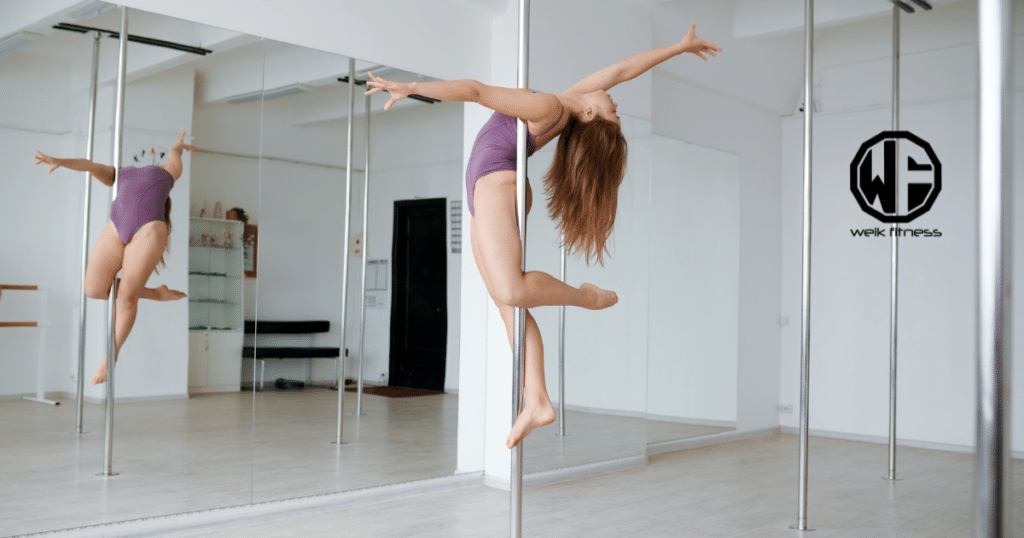
Here are some tips on what to wear for pole fitness classes:
- Shorts: Short shorts made of a stretchy material allow the most skin contact with the pole. Avoid long or baggy shorts that can get in the way.
- Tank tops: Choose fitted tank tops that won’t slide up or shift around during inverted moves. Avoid loose tops that could cover your face accidentally.
- Sports bras: High-support sports bras prevent uncomfortable bouncing during athletic moves. Opt for secure straps.
- Bare skin: Expose legs, shoulders, and torso as much as comfortably possible for grip. Avoid lotions or oils.
- Grip aid: Purchase grip gloves/aids to help stick to the pole, especially as a beginner. Apply to contact points.
- Fitted attire: Form-fitting leggings, shorts, and tanks allow an unrestricted range of motion. Avoid loose clothing that could catch.
- Bare feet: Bare feet or grippy socks provide optimal pole contact and flexion. Avoid shoes.
- Hair tied up: Keep hair securely tied back so it doesn’t whip into your face or obstruct vision.
- Minimal jewelry: Remove dangling jewelry, rings, or bulky accessories that could catch or inhibit movement.
Related Article: Fitness Influencer OnlyFans — What Length Will You Go for Money?
The key is wearing athletic attire that allows your skin maximum contact with the pole without limiting your movement. Check with your studio for any specific policies.
Finding a Pole Fitness Studio and Instructor
Search for pole studios with PFA or XPert-certified instructors. Try intro packages first before larger commitments. Avoid overcrowded classes.
Look for clean, dry poles to maximize grip. Wear shorts and avoid lotions for best pole contact. Expect some bruising initially as your skin adapts. Build strength gradually to avoid injury.
Can You Do Pole Fitness at Home?
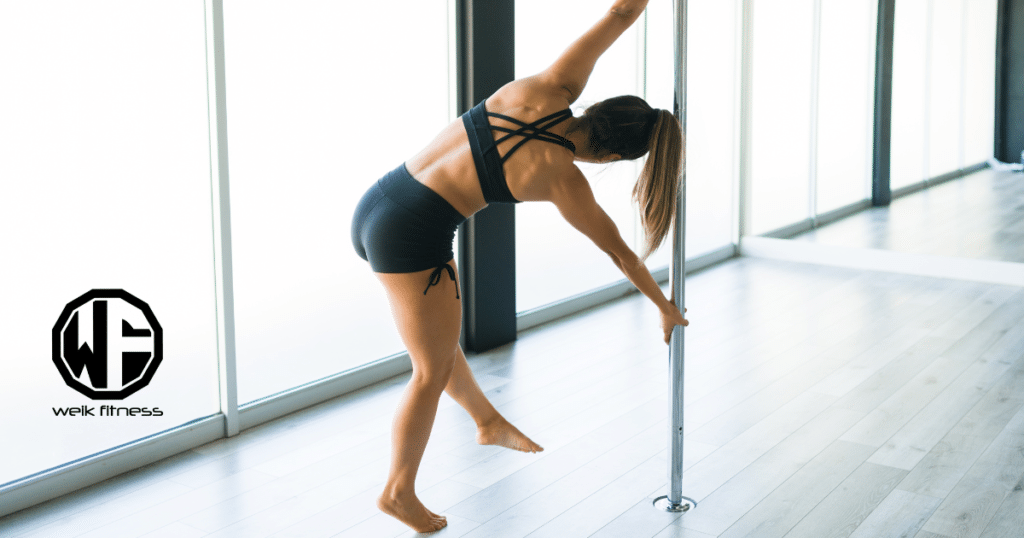
Yes, it’s absolutely possible to practice at home! Here are some tips:
- Purchase a home pole: Look for a free-standing removable pole from trusted brands like X-Pole or Lupit. Consider ceiling clearance required.
- Safety first: Ensure the pole is properly installed per manufacturer instructions. Use crash mats. Check for sturdiness.
- Start slow: Learn fundamentals like climbs, spins, and basic transitions before attempting tricks. Master technique.
- Follow online tutorials: Take virtual classes or use YouTube tutorials to learn skills properly. Don’t self-teach advanced moves.
- Read books on pole fitness: There are many pole fitness books that provide great information (like Strength & Conditioning for Pole and Pole Dance Fitness).
- Consider private lessons: Take occasional in-studio lessons from an instructor to receive feedback on form.
- Allow space: Clear a wide area around the pole free of furniture or obstructions for safety.
- Proper attire: Bare skin for grip. Avoid baggy clothing that can catch. Tie hair back.
- Check your pole: Ensure your pole is cleaned and dried for maximum grip. Don’t use lotions/oils.
- Listen to your body: Training at home allows you to practice at your own pace. Don’t overdo it.
With the right pole setup and smart training, pole fitness at home provides a convenient way to improve skills. Just be sure to prioritize proper technique and safety.
Safety and Precautions
Pole fitness does come with common beginner issues like bruises or soreness as your body adjusts. Make sure to clean poles before use and avoid oils/lotions that reduce grip. Wear proper footwear and grip aid.
Avoid overexertion when starting out. Build up slowly to more advanced tricks. Learn proper technique from the start to prevent strains or injuries down the road. With the proper precautions, pole sessions can be both challenging and safe.
Start Exploring Your Pole Fitness Potential!
Pole fitness allows students of all backgrounds to unlock their athleticism and creative expression. The blend of artistry, flexibility, and strength training creates an inspiring sense of embodiment. Grab a pole and discover your inner power today!
Related Article: Is the Fitness and Bodybuilding Industry a Casting Couch?
FAQ
Yes, pole fitness provides an excellent full-body workout. It builds core and upper body strength, improves flexibility, burns calories, and enhances coordination and body awareness. The blend of dance, gymnastics, and resistance training keeps classes fun and challenging.
Pole fitness engages all major muscle groups including arms, shoulders, back, chest, core, glutes, and legs. It provides strength training for the upper body using just body weight as resistance while improving mobility.
In a one hour pole fitness class, you can expect to burn anywhere from 200-400+ calories depending on your weight and intensity level. More complex routines and dance combinations result in greater calorie burn.
Wear shorts and tops that expose skin for grip. Form-fitting athletic wear allows the most mobility. Bare feet or grip socks only. Tie up long hair. Avoid loose clothing, jewelry, and lotions.


*Disclosure: This article may contain affiliate links or ads, which means we earn a small commission at no extra cost to you if you make a purchase through these links. These commissions help support the operation and maintenance of our website, allowing us to continue producing free valuable content. Your support is genuinely appreciated, whether you choose to use our links or not. Thank you for being a part of our community and enjoying our content.
PLEASE CONSIDER SHARING THIS ON YOUR SOCIAL MEDIA TO HELP OTHERS LEARN MORE ABOUT THIS TOPIC. SIMPLY CLICK BELOW!

